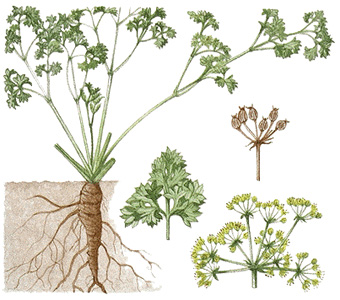Parsley, << PAHRS lee or PAHR slee, >> is a biennial vegetable, sometimes considered as an herb. It is closely related to caraway. The most popular variety produces a low-growing rosette of finely curled and crumpled green leaves. Another variety of parsley produces plain leaves. The fresh leaves are used mainly to decorate meat dishes and salads. The leaves of parsley can also be dried and used in soups.

A special kind of parsley grown in Germany, and occasionally in America, is called Hamburg parsley. This plant produces a long root that may be stored for winter use. Hamburg parsley is used as a soup flavoring.
Parsley is an excellent source of all vitamins. It is especially rich in vitamins A and C and in the minerals iron and calcium. But it is usually eaten in such small quantities that it has little effect on a person’s health.
Parsley seed is sown in greenhouses, hotbeds, or open beds. It sends up leaves slowly and unevenly. The plants are moved to the garden about a week before the last spring frost. From 6 to 10 plants are enough for a family. A few leaves at a time are picked off the plant. Sometimes parsley plants are potted and grown indoors in a sunny window during winter.
Parsley was first grown in Sardinia and southern Italy. Early Romans used parsley to fashion garlands that crowned their military heroes and athletic heroes.
